Exercises (3201)
Roll forwards and backwards
Floor and apparatus gymnastics




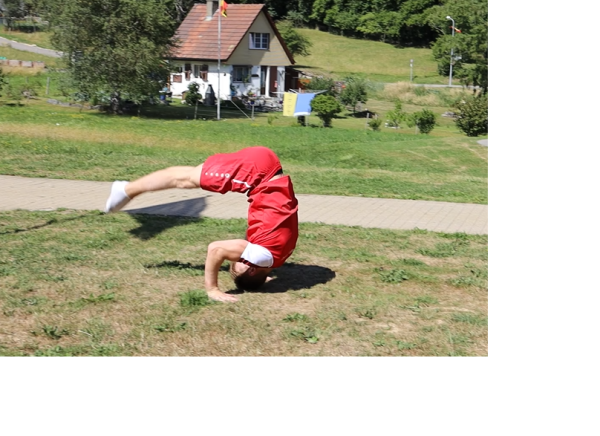


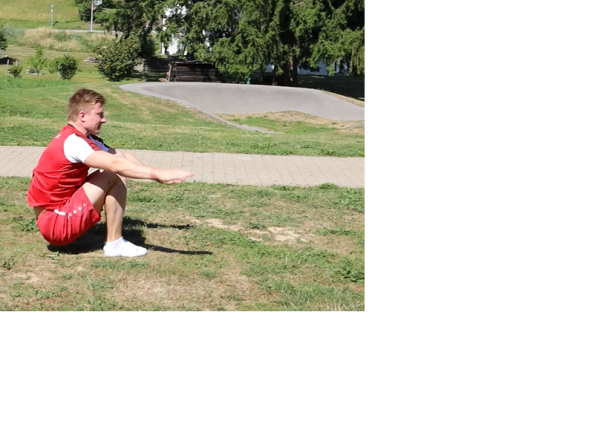








The two rolls are performed one after the other:
Roll fw:
From an upright standing position, perform a forward roll and land back on your feet without using your hands to stand up.
Roll rw:
From a standing position, roll backwards and place your feet on the floor as quickly and as close as possible behind your hands to return to a standing position. Curve the upper body from the top of the head to the tailbone like a tortoise shell during the entire rolling movement. Roll over the upper back and shoulders and not over the head.
The participants practise the form of movement independently using series of pictures or based on the instructor's demonstration of the exercise. The instructor (or a partner) gives feedback, provides support and checks that the exercise is being performed correctly.
4 soft mats (small) ► indoor version
1 row
outdoor:
turf field
Roll forwards
Floor and apparatus gymnastics









From an upright standing position, perform a forward roll and land back on your feet without using your hands when standing up.
The participants practise the movement independently using series of images or based on the instructor's demonstration of the exercise. The instructor (or a partner) gives feedback, provides support and checks that the exercise is being performed correctly.
4 soft mats (small) ► indoor version
1 row
outdoor:
turf field
Roll with raised arms and legs in lateral position left/right
Power
Individual work


Lay on your side, stretch your legs and arms and lift them slightly off the floor. Pull your navel towards your spine and consciously tense your abdomen and then change your side position without changing your body position (roll alternately to the right or left side).
Attention:
Stretched arms and legs practically form a line.
Lighten:
Just hold the position with your arms and legs raised and switch sides from time to time.
Harden:
Add weight to your arms and/or legs.
2-4 weight cuffs/2 weight balls/dumbbells ► Make the exercise more difficult (additional weight)
Rollmops
Stimulate circulation
Group work
2 teams
Two teams face each other behind two defined lines. In the centre of the two lines are 2-3 gym balls/kin balls/volleyballs, which are to be rolled behind the opponent's baseline or a defined line with targeted shots/throws by the participants (by hand, with the foot or with the playing equipment). Balls may only be shot at the target ball from behind one's own baseline. The throwing line, but not the centre line, may be crossed to retrieve the throwing balls. There are numerous balls in both throwing zones at the start of the game (e.g. handball, football, basketball, volleyball, floorball, etc.).
Caution:
It is forbidden to shoot/throw directly at the opposing team's players and care must be taken not to be hit by approaching balls when retrieving them.
Per participant:
1 racket/stick ►intercrosse/lacrosse, smolball, floorball
1-3 exercise balls/kine balls/volleyballs/medicine balls ►goals
x balls ►basketball, FooBaSKILL, futsal/football, handball, intercrosse/lacrosse, smolball, tchoukball, floorball
Rotation of the upper body in frontal stance to the wall (left) ► standing upper body rotation
Power
Individual work

Stand upright in front of a wall, shoulder-width apart (facing the wall), with arms bent (approximately 90 degrees at the elbow joint), holding a medicine ball in front of the body with both hands slightly below chest height. The upper body is turned/rotated as far as possible to the left side (gaze follows the movement), while the legs and arms remain stable (lift the heel on the opposite side - right - as far as possible). Then swing the upper body back to the starting position and at the same time throw the ball (sideways) against the wall. Catch the ball and return to the starting position to restart the exercise.
Attention:
Tighten your stomach, keep your back straight, your pelvis remains in place and only your upper body moves.
Lighten:
Smaller movements (less rotation); lighter ball.
Harden:
Additional weight (on the arms); heavier ball; unstable base.
1 wall
1 medicine ball
1 volleyball or football ► make the exercise easier
2 weight cuffs ► make the exercise more difficult (additional weight)
1-2 balance cushions/1 balance board ► make the exercise more difficult (unstable surface)
Rotation of the upper body in frontal stance to the wall (right) ► standing upper body rotation
Power
Individual work

Stand upright in front of a wall, shoulder-width apart (facing the wall), with arms bent (approximately 90 degrees at the elbow joint), holding a medicine ball in front of the body with both hands slightly below chest height. The upper body is turned/rotated as far as possible to the right side (gaze follows the movement), while the legs and arms remain stable (lift the heel on the opposite side - left - as far as possible). Then swing the upper body back to the starting position and at the same time throw the ball (sideways) against the wall. Catch the ball and return to the starting position to restart the exercise.
Attention:
Tighten your stomach, keep your back straight, your pelvis remains in place and only your upper body moves.
Lighten:
Smaller movements (less rotation); lighter ball.
Harden:
Additional weight (on the arms); heavier ball; unstable base.
1 wall
1 medicine ball
1 volleyball or football ► make the exercise easier
2 weight cuffs ► make the exercise more difficult (additional weight)
1-2 balance cushions/1 balance board ► make the exercise more difficult (unstable surface)
Rotation of the upper body in frontal stance alternating to the wall ► standing upper body rotation
Power
Individual work


Stand upright, shoulder-width apart, in front of a wall (facing the wall), with arms bent (approximately 90 degrees at the elbow joint), holding a medicine ball in front of the body with both hands slightly below chest height. The upper body is turned/rotated as far as possible to the side (gaze accompanies the movement), while the legs and arms remain stable (lift the heel on the opposite side of the rotation movement at most). Then swing the upper body back to the starting position and at the same time throw the ball (sideways) against the wall. Catch the ball and return to the starting position to start the same exercise on the other side.
Attention:
Tighten your abdomen, keep your back straight, your pelvis stays in place and only your upper body moves.
Lighten:
Smaller movements (less rotation); lighter ball.
Harden:
Additional weight (on the arms); heavier ball; unstable base.
1 wall
1 medicine ball
1 volleyball or football ► make the exercise easier
2 weight cuffs ► make the exercise more difficult (additional weight)
1-2 balance cushions/1 balance board ► make the exercise more difficult (unstable surface)
Rotation of the upper body while standing sideways to the wall (left) ► standing upper body rotation
Power
Individual work


Stand upright in front of a wall (facing the wall horizontally, left shoulder closer to the wall), with arms bent (approximately 90 degrees at the elbow joint), hold a medicine ball in front of the body with both hands slightly below chest height. The upper body is turned/rotated to the side towards the wall in a swinging motion (gaze accompanies the movement) until the arms are facing the wall and the ball is thrown against the wall at the same time. During the rotation movement, the legs and arms remain stable (lift the heel of the foot furthest from the wall at most). Catch the ball and bring your upper body back to the starting position.
Attention:
Tighten your stomach, keep your back straight, your pelvis remains in place and only your upper body moves.
Lighten:
Smaller range of motion by pointing the stance more towards the wall (less rotation); lighter ball.
Harden:
Additional weight (on the arms); heavier ball; unstable base.
1 wall
1 medicine ball
1 volleyball or football ► make the exercise easier
2 weight cuffs ► make the exercise more difficult (additional weight)
1-2 balance cushions/1 balance board ► make the exercise more difficult (unstable surface)
Rotation of the upper body while standing sideways to the wall (right) ► standing upper body rotation
Power
Individual work


Stand upright in front of a wall (facing the wall horizontally, right shoulder closer to the wall), with arms bent (approximately 90 degrees at the elbow joint), hold a medicine ball in front of the body with both hands slightly below chest height. The upper body is turned/rotated to the side towards the wall in a swinging motion (gaze accompanies the movement) until the arms are facing the wall and the ball is thrown against the wall at the same time. During the rotation movement, the legs and arms remain stable (lift the heel of the foot furthest from the wall at most). Catch the ball and bring your upper body back to the starting position.
Attention:
Tighten your stomach, keep your back straight, your pelvis remains in place and only your upper body moves.
Lighten:
Smaller range of motion by pointing the stance more towards the wall (less rotation); lighter ball.
Harden:
Additional weight (on the arms); heavier ball; unstable base.
1 wall
1 medicine ball
1 volleyball or football ► make the exercise easier
2 weight cuffs ► make the exercise more difficult (additional weight)
1-2 balance cushions/1 balance board ► make the exercise more difficult (unstable surface)
Rotation of the upper body in lateral forearm support (left) ► rotational lateral pillar bridge / side bridge
Power
Individual work


Side support on the (left) forearm and vertically extended upper arm, looking upwards, bring the upper arm under the body and back to the starting position, accompany the movement with your head (looking down from above).
Attention:
Pelvis remains stable.
Lighten:
Knees on the floor.
Harden:
Additional weight (for the free arm); unstable base (possible for both the supporting arm and the legs).
1 weight cuff/dumbbell ► making the exercise more difficult (additional weight)
1 ball/1-2 balance cushions/1 balance board ► making the exercise more difficult (unstable surface)
Rotation of the upper body in lateral forearm support (left) ► rotational lateral pillar bridge / side bridge
Power
Individual work
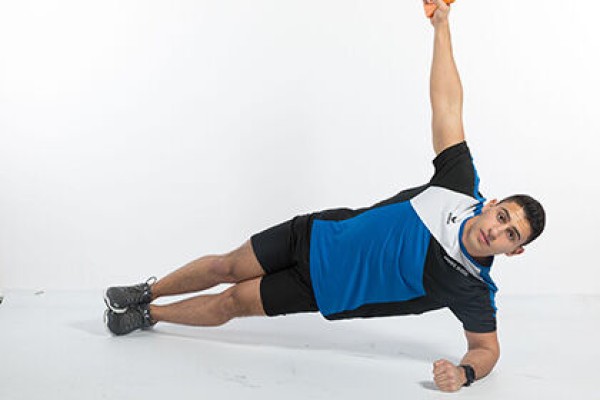

Side support on the (left) forearm and vertically extended upper arm, hold the pistol in the free hand, look towards the weapon, bring the pistol under the body and back to the starting position, accompany the movement with the head (look from top to bottom).
Attention:
Pelvis remains stable.
Lighten:
Knees on the floor.
Harden:
Instable support (possible for both the supporting arm and the legs).
1 pistol (neutralised)
1 ball/1-2 balance cushions/1 balance board ► Make the exercise more difficult (unstable surface)
Rotation of the upper body in lateral forearm support (left) ► rotational lateral pillar bridge / side bridge
Power
Individual work


Side support on the (left) forearm and vertically extended upper arm, hold the dumbbell in your free hand, look towards the weight, bring the dumbbell under your body and back to the starting position, accompany the movement with your head (look down from above).
Attention:
Keep your pelvis stable; keep the shoulder of the supporting arm above your elbow.
Lighten:
Knees on the floor.
Harden:
Stable support (possible for both the supporting arm and the legs).
1 dumbbell
1 ball/1-2 balance cushions/1 balance board ► Make the exercise more difficult (unstable surface)
Rotation of the upper body in lateral forearm support (left) ► rotational lateral pillar bridge / side bridge
Power
Individual work


Side support on the (left) forearm and vertically extended upper arm, feet on the balance board, look towards the free arm, bring the playing arm under the body and back to the starting position, accompany the movement with your head (look from top to bottom).
Attention:
The pelvis remains stable; keep the shoulder of the supporting arm above the elbow.
Lighten:
Without an unstable base.
Harden:
Instant base for the supporting arm as well; hold additional weight in the free hand.
1 balance board
1 ball/1-2 balance cushions/1 balance board ► Make the exercise more difficult (unstable surface)
1 dumbbell ► Make the exercise more difficult (additional weight)
Rotation of the upper body in lateral forearm support (right)
Power
Individual work
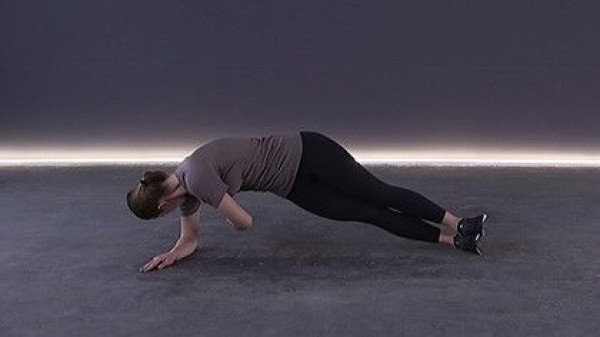

Side support on the (right) forearm and vertically extended upper arm, looking upwards, bring the upper arm under the body and back to the starting position, accompany the movement with your head (looking down from above).
Attention:
Pelvis remains stable.
Lighten:
Knees on the floor.
Harden:
Additional weight (for the free arm); unstable base (possible for both the supporting arm and the legs).
1 weight cuff/dumbbell ► making the exercise more difficult (additional weight)
1 ball/1-2 balance cushions/1 balance board ► making the exercise more difficult (unstable surface)
Rotation of the upper body in lateral forearm support (right) ► rotational lateral pillar bridge / side bridge
Power
Individual work


Side support on the (right) forearm and vertically extended upper arm, hold the pistol in the free hand, look towards the weapon, bring the pistol under the body and back to the starting position, accompany the movement with the head (look from top to bottom).
Attention:
Pelvis remains stable.
Lighten:
Knees on the floor.
Harden:
Instable support (possible for both the supporting arm and the legs).
1 pistol (neutralised)
1 ball/1-2 balance cushions/1 balance board ► Make the exercise more difficult (unstable surface)
Rotation of the upper body in lateral forearm support (right) ► rotational lateral pillar bridge / side bridge
Power
Individual work


Side support on the (right) forearm and vertically extended upper arm, hold the dumbbell in your free hand, look towards the weight, bring the dumbbell under your body and back to the starting position, accompany the movement with your head (look down from above).
Attention:
Pelvis remains stable; rotation of the upper body in lateral forearm support.
Lighten:
Knees on the floor.
Harden:
Instable support (possible for both the supporting arm and the legs).
1 dumbbell
1 ball/1-2 balance cushions/1 balance board ► Make the exercise more difficult (unstable surface)
Rotation of the upper body in lateral forearm support (right) ► rotational lateral pillar bridge / side bridge
Power
Individual work


Side support on the (right) forearm and vertically extended upper arm, feet on the balance board, look towards the free arm, bring the playing arm under the body and back to the starting position, accompany the movement with your head (look from top to bottom).
Attention:
Pelvis remains stable; keep the shoulder of the supporting arm above the elbow.
Lighten:
Without an unstable base.
Heavier:
Instable base also for the supporting arm; hold additional weight in the free hand.
1 balance board
1 ball/1-2 balance cushions/1 balance board ►Make the exercise more difficult (unstable surface)
1 dumbbell ►Make the exercise more difficult (additional weight)
Rotation of the upper body in lateral forearm support with dumbbells (left) ► rotational lateral pillar bridge / side bridge
Power
Individual work
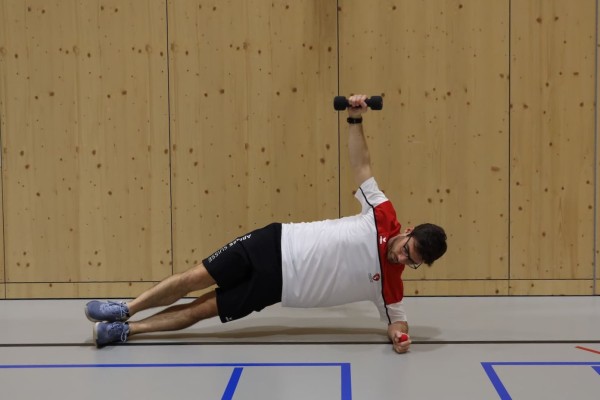
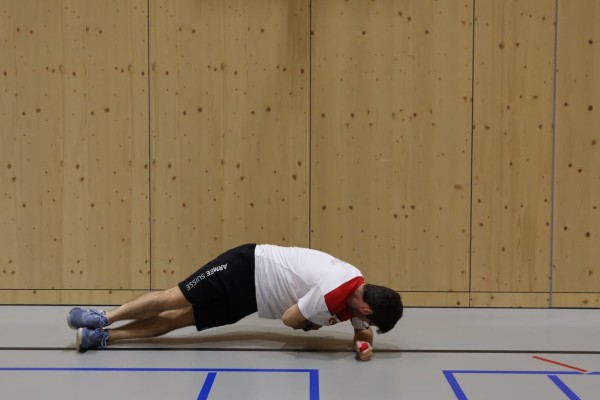
Side support on the (left) forearm and vertically extended upper arm, hold the dumbbell in your free hand, bring the dumbbell under your body and back to the starting position.
Attention:
Keep your pelvis stable; keep the shoulder of the supporting arm above your elbow.
Lighten:
Perform without dumbbells; do the exercise on your knees.
Harden:
More weight.
1 dumbbell
Rotation of the upper body in lateral forearm support with dumbbells (right) ► rotational lateral pillar bridge / side bridge
Power
Individual work
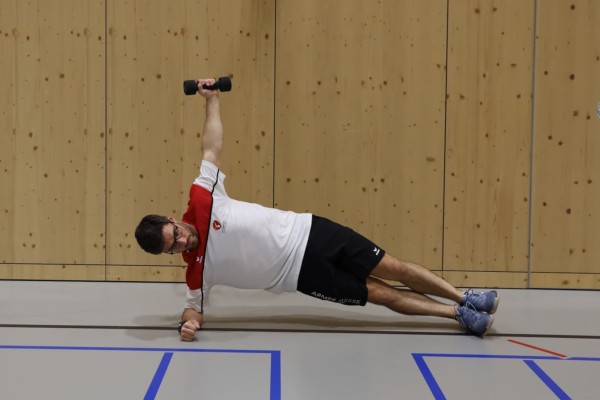
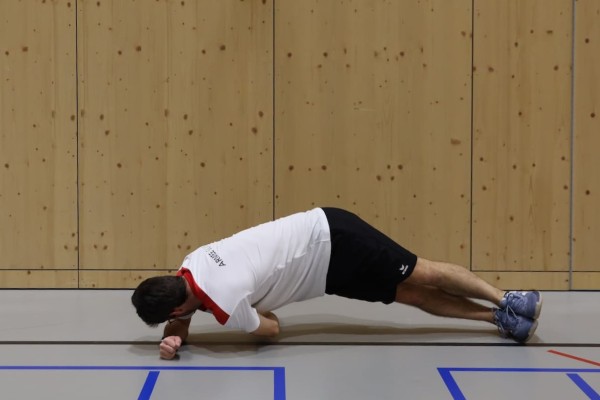
Side support on the (right) forearm and vertically extended upper arm, hold the dumbbell in your free hand, bring the dumbbell under your body and back to the starting position.
Attention:
Keep your pelvis stable; keep the shoulder of the supporting arm above your elbow.
Lighten:
Perform without dumbbells; do the exercise on your knees.
Harden:
More weight.
1 dumbbell
Rotation of the upper body in side support (left) ► rotational pillar bridge
Power
Individual work

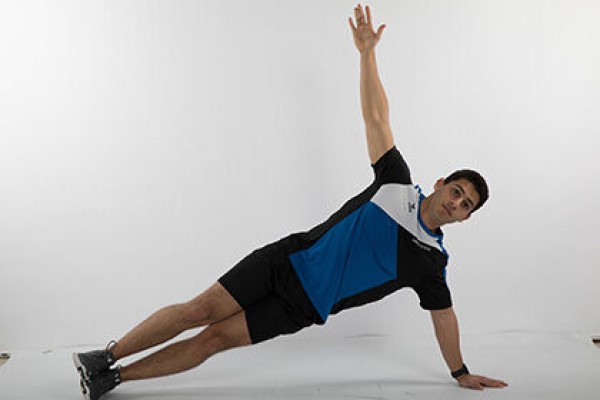
Lateral support with outstretched (left) arm, upper arm also outstretched (held vertically upwards), gaze directed upwards, bring upper arm under the body and back to the starting position, accompany the movement with the head (gaze directed downwards from above).
Attention:
Pelvis remains stable.
Lighten:
Knees on the floor.
Heavier:
Additional weight (for the free arm); unstable base (possible for both the supporting arm and the legs).
1 weight cuff/dumbbell ►making the exercise more difficult (additional weight)
1 ball/1-2 balance cushions/1 balance board ►making the exercise more difficult (unstable surface)
Rotation of the upper body in side support (left) ► rotational pillar bridge
Power
Individual work


Lateral support with the (left) arm extended, upper arm holding the dumbbell also extended (vertically upwards in a high hold), gaze directed upwards, bring the upper arm under the body and back to the starting position, accompany the movement with the head (gaze directed downwards from above).
Attention:
Pelvis remains stable.
Lighten:
Knees on the floor; no weight for the free arm.
Heavier:
More weight; unstable base (possible for both the supporting arm and the legs).
1 dumbbell
1 ball/1-2 balance cushions/1 balance board ►Make the exercise more difficult (unstable surface)
Rotation of the upper body in lateral support (right) ► rotational pillar bridge
Power
Individual work


Lateral support with the (right) arm stretched out, upper arm also stretched out (vertically upwards in a high position), gaze directed upwards, bring the upper arm under the body and back to the starting position, accompany the movement with the head (gaze directed downwards from above).
Attention:
Pelvis remains stable.
Lighten:
Knees on the floor.
Heavier:
Additional weight (for the free arm); unstable base (possible for both the supporting arm and the legs).
1 weight cuff/dumbbell ►making the exercise more difficult (additional weight)
1 ball/1-2 balance cushions/1 balance board ►making the exercise more difficult (unstable surface)
Rotation of the upper body in lateral support (right) ► rotational pillar bridge
Power
Individual work


Side plank with the (right) arm extended, upper arm holding the dumbbell also extended (vertically upwards in a high position), look upwards, bring the upper arm under the body and back to the starting position, accompany the movement with your head (look down from above).
Attention:
Pelvis remains stable.
Lighten:
Knees on the floor; no weight for the free arm.
Heavier:
More weight; unstable base (possible for both the supporting arm and the legs).
1 dumbbell
1 ball/1-2 balance cushions/1 balance board ►Make the exercise more difficult (unstable surface)
Rotation of the upper body in the seat (left) ► seated chop
Power
Individual work


Attach the elastic band to the wall bars (or e.g. a tree) at head height, sit upright on a long bench/swinging box top/chair at a 90 degree angle to the wall bars (to the tree), keep your legs shoulder-width apart, grasp the elastic band at shoulder height with both hands, move your upper body to the far (right) knee/thigh and return to the starting position, keeping your arms stable.
Caution:
Work from the torso and not with the arms.
Easier:
Choose an elastic band with less resistance.
Harder:
Choose an elastic band with greater resistance.
1 elasticated rubber band
1 wall bars/tree
1 long bench/1-2 swing box elements (incl. top section)/chair
Rotation of the upper body in the seat (right) ► seated chop
Power
Individual work


Attach the elastic band to the wall bars (or e.g. a tree) at head height, sit upright on a long bench/swinging box top/chair at a 90 degree angle to the wall bars (to the tree), keep your legs shoulder-width apart, grasp the elastic band at shoulder height with both hands, move your upper body to the far (left) knee/thigh and return to the starting position, keeping your arms stable.
Caution:
Work from the torso and not with the arms.
Lighten:
Choose an elastic band with less resistance.
Heavier:
Choose an elastic band with greater resistance.
1 elasticated rubber band
1 wall bars/tree
1 long bench/1-2 swing box elements (incl. top section)/chair